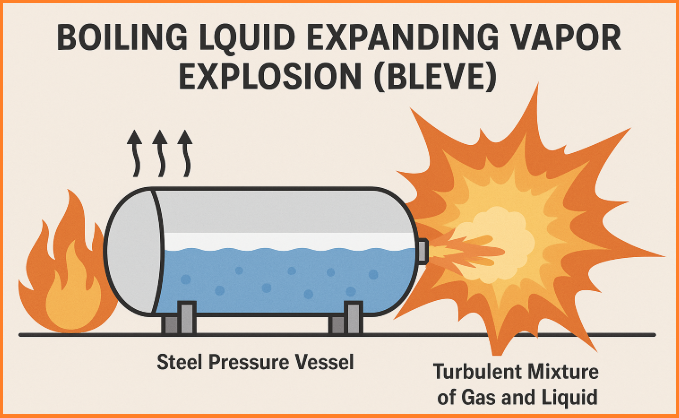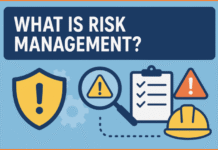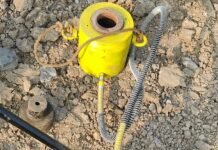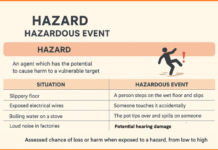A Boiling Liquid Expanding Vapor Explosion (BLEVE) is a violent and potentially catastrophic event that occurs when a pressurized vessel containing a liquid above its boiling point ruptures. This type of explosion is classified as a physical explosion, and it typically involves flammable hydrocarbon liquids such as Liquefied Petroleum Gas (LPG), although non-flammable liquids can also be involved.
Contents
How BLEVE Happens
- Vessel Under Pressure: Industrial pressure vessels are designed to store liquids like LPG under high pressure. These liquids exist in a saturated state, meaning they are in equilibrium with their vapors.
- External Heating (Often Fire): When such a vessel is exposed to external heat—most commonly due to a fire—the liquid inside begins to absorb heat and the internal vapor pressure increases.
- Vapor Expansion: As the temperature rises, the liquid tries to boil, producing more vapor. The relief valve installed on the vessel is designed to release excess pressure, but it may not be able to keep up with the rapid vapor generation.
- Structural Weakening: Continuous heating weakens the steel wall of the vessel, particularly at the liquid-vapor interface, where the vessel is not cooled by the liquid. Eventually, the metal becomes too weak to withstand the pressure.
- Sudden Rupture: When the vessel can no longer hold the internal pressure, it ruptures catastrophically. The superheated liquid flashes into vapor almost instantaneously, expanding rapidly and creating a turbulent explosion.
Consequences of a BLEVE
- Blast Wave: The rapid vaporization leads to a shock wave similar to other high-energy explosions.
- Fireball: If the released vapor is flammable, it can ignite immediately, forming a large fireball.
- Projectile Hazards: The rupture can launch fragments of the pressure vessel over great distances, posing a risk to personnel and property.
- Secondary Fires and Explosions: The blast may trigger other fires or explosions in the surrounding area.
Real-World Examples
- LPG tank truck accidents have frequently resulted in BLEVEs, often with devastating consequences.
- The 1978 Los Alfaques disaster in Spain involved a tanker carrying liquefied propane; the BLEVE killed over 200 people.
Prevention and Safety Measures
- Thermal insulation and fireproofing of vessels to reduce heat absorption.
- Water spray systems to cool vessels exposed to fire.
- Pressure relief devices must be properly sized and maintained.
- Safe separation distances between storage vessels and occupied areas.
- Emergency response planning including evacuation zones in case of BLEVE.
What safety measures can prevent BLEVEs?
Safety measures include thermal insulation, water spray systems to cool vessels, properly maintained pressure relief devices, safe separation distances, and emergency response planning.
Can you give examples of real-world incidents involving BLEVEs?
Yes, examples include LPG tank truck accidents and the 1978 Los Alfaques disaster in Spain, which resulted in fatalities and extensive damage.
What are the main consequences of a BLEVE?
The main consequences include a blast wave, fireball, projectile hazards from launching vessel fragments, and secondary fires or explosions in the surrounding area.
How does a BLEVE occur?
A BLEVE occurs when a vessel under pressure is exposed to external heat, such as a fire, causing the internal vapor pressure to increase until the vessel weakens and ruptures, leading to rapid vaporization and explosion.
What is a Boiling Liquid Expanding Vapor Explosion (BLEVE)?
A BLEVE is a violent explosion that occurs when a pressurized vessel containing a liquid above its boiling point ruptures, often involving flammable hydrocarbon liquids like LPG.
BLEVE is a critical safety concern in industries handling pressurized liquids, particularly hydrocarbons. It represents the dangerous intersection of heat, pressure, and structural failure. Understanding the mechanisms behind BLEVE and implementing preventive measures are essential to protect lives, infrastructure, and the environment.





